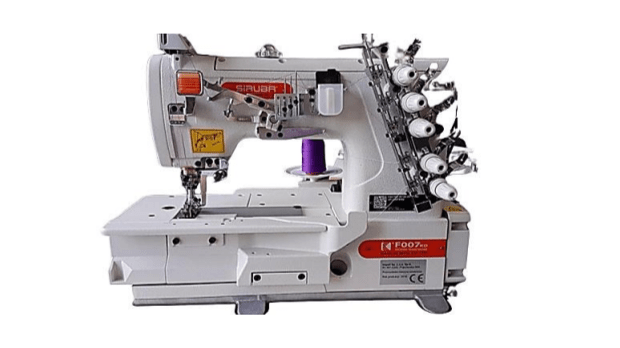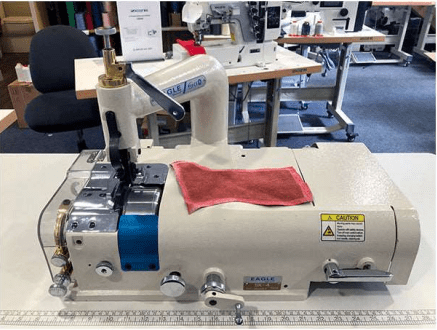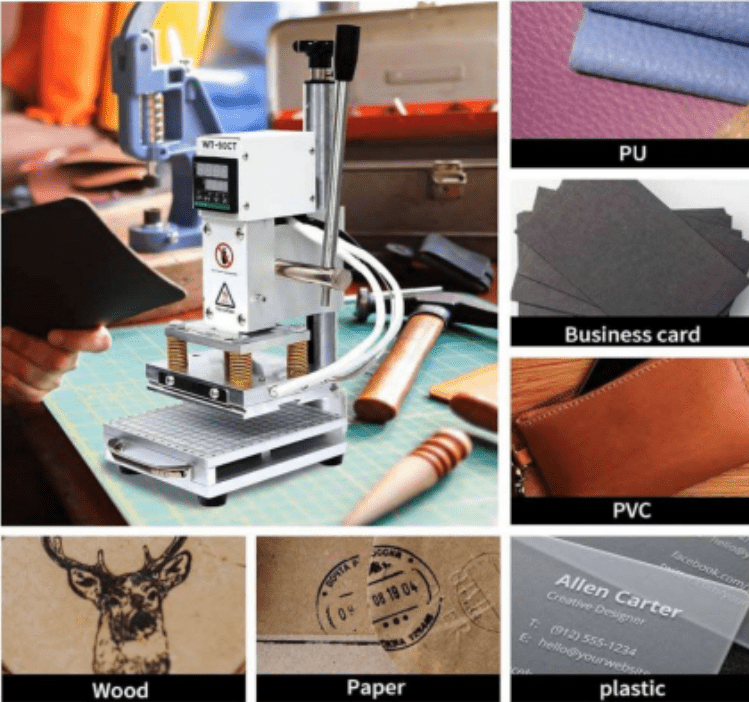Blog
DETAILED INFORMATION ABOUT DOUBLE CHAIN STITCH MACHINE

15 Minute read
LET READ !
The double chain stitch sewing machine has a rich history
that dates back to the early 19th century.
It was invented by the French tailor,
Thimonnier, in 1830.
Thimonnier’s machine was a significant
breakthrough in the world of sewing, as it could
produce a continuous series of interconnected
loops, creating a strong and flexible stitch.
The invention of the chain stitch sewing
machine revolutionized the garment industry.
Before its advent, all sewing was done by
hand, which was a slow and labor-intensive process.
The chain stitch sewing machine marked the
beginning of automation in the textile industry,
significantly increasing the efficiency of garment
production.
A chain stitch machine is a type of sewing
machine that uses a single thread to create a strong
and flexible chain-like stitch, suitable for heavy
fabrics and stretchy applications.
It is a versatile and efficient machine, but
may require more skill to operate and maintain
than other machines.
FEATURES
Important features that make a double chain stitch sewing
machine different:
- Single thread: Uses only one thread to create a
chain-like stitch, making it strong and flexible. - High-speed stitching: Capable of fast stitching
speeds, making it efficient for large-scale
production. - Strong and flexible stitch : Creates a sturdy and
elastic stitch suitable for heavy fabrics and
stretchy applications. - Needle or 2-Needle options
- Flatbed design
- Bottom feed transport
- Built-in energy-saving motor
- Low vibration and noise level
- LED lighting of sewing area
- Semi-Dry Head with grease lubrication
- DLC needle bar (Carbon)
PROCESSES INVOLVED IN USING A JACK DOUBLE CHAIN
STITCH SEWING MACHINE:
- THREADING: Thread the machine with a single
thread, following the manufacturer’s
guidelines. - Setting stitch length: Adjust the stitch length to
suit the fabric and application. - Selecting fabric: Choose the fabric to be sewn,
ensuring it is suitable for chain stitch. - Placing fabric under presser foot : Position the
fabric under the presser foot, aligning the edge
with the guide. - Starting the machine: Turn on the machine and
begin sewing, slowly and steadily. - Guiding the fabric: Use the feed dog to guide
the fabric smoothly and consistently. - Sewing: Continue sewing, maintaining a steady
pace, until the desired length is achieved. - Backstitching: Reinforce the stitches by sewing
in reverse at the beginning and end. - Cutting thread: Cut the thread, leaving a small
tail.

FUNCTIONS OF EACH PART
- Thread Take-Up Lever is a mechanism that
pulls the thread up and away from the needle,
creating a consistent and even stitch length,
and helping to prevent thread bunching and
tangling
2.A Switch Regulator is a component in a sewing
machine that controls the amount of thread
that is released from the spool, regulating the
tension of the thread and ensuring a consistent
stitch quality.
In essence, the Switch Regulator acts
as a “traffic cop” for the thread, ensuring that
the right amount of thread is released at the
right time, resulting in a professional-looking
stitch.
3.A Switch Selector or Display Screen is a control
panel on a sewing machine that allows the user
to select various stitch options, settings, and
features, and displays the chosen settings and
information, making it easy to navigate and
customize the sewing process.
4.A Double Needle is also commonly known as a
“Twin Needle” or “Double Pitch Needle”. A
Double Needle is a specialized sewing machine
needle that has two parallel needles mounted
together, allowing for the simultaneous sewing
of two parallel rows of stitches, typically used
for sewing heavy fabrics, creating a strong and
durable seam, and adding a decorative touch to
garments and home decor items. Two Needle
Positions
It is possible to set the high and low needle
position from the digital display.

5.A Slide Plate,: also known as a Slide Presser
Foot or Slide Feed Dog, is a mechanism on a
sewing machine that allows for smooth and
easy movement of the fabric being sewn, by
sliding the presser foot or feed dog along a
track or groove, enabling effortless feeding of
the fabric and consistent stitching.
6.Presser feet; on a double chain stitch machine guide
and control the fabric, ensuring consistent and
precise stitching, and facilitating smooth fabric
feeding and decorative stitching capabilities.
7.The Needle Clamps (or Needle Cramps) of a double
chain stitch sewing machine hold the needle
firmly in place, enabling precise control and
consistent stitch quality.
8.Presser feet control refers to the mechanism
that regulates the pressure and movement of
the presser foot on a sewing machine, allowing
the user to adjust the amount of pressure
exerted on the fabric and control the fabric’s
movement under the needle.
USES/BENEFIT OF DOUBLE CHAIN STITCH SEWING
MACHINE
Chain stitch machines have several uses and
benefits, including:
- Sewing heavy fabrics: Chain stitch
machines are ideal for sewing thick, heavy, or
dense fabrics like denim, canvas, and leather. - Reinforcing seams: Chain stitch machines
create strong, durable seams, making them
perfect for reinforcing stress points on
garments, bags, and home decor items. - Decorative stitching: Chain stitch machines
can create decorative stitches, such as
embroidery, topstitching, and edging. - Quick sewing: Chain stitch machines are fast
and efficient, making them ideal for large-scale
sewing projects, like sewing curtains,
upholstery, and canvas tarps. - Industrial applications: Chain stitch machines
are widely used in industries like textile, leather,
and manufacturing for heavy-duty sewing tasks. - Repair work: Chain stitch machines are great
for repair work, like fixing torn seams,
reattaching buttons, and mending holes. - Crafting: Chain stitch machines are used in
various crafts, such as quilting, embroidery, and
home decor projects. - Consistency: Chain stitch machines produce
consistent, high-quality stitches, making them
perfect for production sewing.
MAINTENANCE MEASURES FOR THE 1-NEEDLE,
FLATBED CHAIN STITCH DOUBLE CHAIN STITCH
SEWING MACHINE:
- Regular Cleaning:
- Clean the machine’s head, needle area, and
surrounding parts regularly with a soft brush
and dry cloth. - Remove any debris, dust, or thread ends.
2. Lubrication:
- Apply grease to the machine’s moving parts,
such as the needle bar, feed dog, and presser
foot. - Use the recommended type and amount of
grease to avoid excessive lubricant buildup.
3. Needle Maintenance:
- Regularly inspect and replace worn or
damaged needles. - Use the correct needle type and size for the
specific fabric and stitch type.
4. Thread Management:
- Regularly clean and inspect the thread take up lever and tension discs.
- Ensure proper thread tension to prevent
thread breaks and knots.
5. Feed Dog Maintenance:
- Regularly clean and inspect the feed dog
and its surrounding area. - Ensure proper feed dog alignment and
adjustment.
6. Presser Foot Maintenance:
- Regularly clean and inspect the presser foot
and its surrounding area. - Ensure proper presser foot alignment and
adjustment.
7. Motor Maintenance:
- Regularly inspect and replace worn or
damaged belts. - Use the recommended type and size of belt.
- Belt Replacement:
- Regularly inspect and replace worn or
damaged belts. - Use the recommended type and size of belt.
9. Screw and Bolt Tightening:
- Regularly inspect and tighten any loose
screws and bolts. o - Ensure proper tightening to prevent
machine vibration and noise.
- Manufacturer’s Guidelines:
- Follow the manufacturer’s recommended
maintenance schedule and guidelines. - Refer to the user manual and maintenance
manual for specific instructions.
By following these maintenance measures, you
can ensure optimal machine performance,
prevent breakdowns, and extend the machine’s
lifespan.
SAFETY MEASURES FOR THE 1-NEEDLE,
FLATBED CHAIN STITCH, DOUBLE CHAIN STITCH
SEWING MACHINE:
- Personal Protective Equipment:
- Wear protective gloves to prevent hand
injuries. - Wear safety glasses or goggles to prevent
eye injuries. - Wear a dust mask to prevent inhalation of
thread and fabric particles.
2. Machine Guarding:
- Ensure all machine guards are in place and
functioning properly. - Never remove or tamper with machine
guards.
3. Proper Training:
- Ensure proper training and experience
before operating the machine. - Read and understand the user manual and
safety guidelines.
4. Work Area Safety:
- Keep the work area clean, well-lit, and free
of clutter. - Ensure good ventilation to prevent
inhalation of thread and fabric particles.
5. Electrical Safety:
- Ensure the machine is properly grounded
and plugged into a grounded outlet. - Avoid overloading the machine with
excessive fabric or thread.
6. Machine Maintenance:
- Regularly inspect and maintain the machine
to prevent mechanical failures. - Follow the manufacturer’s recommended
maintenance schedule.
7. Emergency Stop
- Ensure easy access to the emergency stop
button or switch. - Know how to properly stop the machine in
case of an emergency.
8. Fire Prevention:
- Keep a fire extinguisher nearby.
- Ensure proper disposal of thread and fabric
scraps to prevent fires.
9. Ergonomic Safety:
- Ensure proper seating and posture while
operating the machine. - Take regular breaks to prevent fatigue and
musculoskeletal disorders.
10. Manufacturer’s Guidelines:
- Follow the manufacturer’s recommended
safety guidelines and precautions.
QUESTIONS
Using the diagram below answer question 1_10
by naming the components labeled (A) to (H)

1)The components labeled A is known as____________
A)Thread take_up lever
B)Presser feet
C)Switch Regulator
D) Slide Plate
2)The component labeled C is known as
A)Switch selector
B)Display screen
C) All of the above
D) None
3)The component labeled as B is known
as_______________
A)SWITCH REGULATOR
B)Switch selector
C)Slide plate
D) Needle cramps
4)The components labeled as D is known
as____________________
A)Double Needle
B)Presser foot
C)Thread take_up lever
D) Presser feet control
5)The component labeled as E is known as__________
A)Presser foot
B)Slide Plate
C)Needle cramps
D) Switch Regulator
6)The component labeled as F is known as___________
A)Control switch
B)Spool pin
C)Needle Cramps
D) Presser feet
7)The component labeled as G is known as__________
A)Pressure
B)Energy loom
C)Needle Cramps
D) Clamps
8)The components labeled as H is known as_________
A)Presser feet control
B)Pressure feet control
C)Control switch
D) Switch Regulator
PARTS B
Choose the correct answer from the options
9)Who invented the chain stitch sewing
machine in 1830?___________
A) Thimonnier
B) Elias Howe
C) Isaac Singer
D) Allen B. Wilson
10) What was the significant breakthrough
of Thimonnier’s machine?_________
A) It could produce a continuous series of
interconnected loops
B) It could sew only straight line
C) It could sew only curved lines
D) It could sew only heavy fabrics
11) What was the impact of the chain stitch
sewing machine on the garment industry?
A) It decreased efficiency
B) It increased efficiency
C) It had no impact
D) It made sewing machines obsolete
12) What type of sewing was done before
the advent of the chain stitch sewing
machine?__________
A) Machine sewing
B) Hand sewing
C) Automated sewing
D) Computerized sewing
13) What is a characteristic of the stitch
produced by a chain stitch sewing machine?
A) Strong and flexible
B) Weak and brittle
C) Rigid and inflexible
D) Loose and uneven
14)What is a feature of a chain stitch sewing
machine?____________
A) Uses multiple threads
B) Uses a single thread
C) Can only sew straight lines
D) Can only sew curved lines
15)What is an advantage of a chain stitch
sewing machine?_________
A) It is slow and labor-intensive
B) It is efficient for large-scale production
C) It is only suitable for light fabrics
D) It is difficult to operate and maintain
16) What type of fabrics is a chain stitch
sewing machine suitable for?_
A) Heavy and stretchy fabrics
B) Light and delicate fabrics
C) Only cotton fabrics
D) Only silk fabrics
17)How many threads does a chain stitch
sewing machine use?__________
A) Multiple threads
B) A single thread
C) Two threads
D) Three threads
18)What is a benefit of using a chain stitch
sewing machine?________
A) It increases production time
B) It decreases production time
C) It has no impact on production time
D) It is not suitable for production
- What does the Thread Take-Up Lever
do?_________
A) Regulates thread tension
B) Pulls thread up and away from needle
C) Cuts excess thread
D) None of the above - What does the Switch Regulator
control?___________
A) Thread tension
B) Fabric movement
C) Needle position
D) Stitch length - What is the purpose of the Switch
Selector?_____
A) To select stitch options
B) To regulate thread tension
C) To control fabric movement
D) To adjust needle position - What is the advantage of using a Double
Needle?________
A) Sewing heavy fabrics
B) Creating decorative stitches
C) Reducing thread tension
D) All of the above - What does the Slide Plate
enable?_________
A) Smooth fabric movement
B) Consistent thread tension
C) Easy needle threading
D) None of the above - What do Presser feet guide?__________
A) Fabric and stitching
B) Thread and needle
C) Fabric only
D) Stitching only - What do Needle Clamps hold?__________
A) Thread in place
B) Needle firmly
C) Fabric in place
D) None of the above - What does Presser feet control
regulate?___________
A) Pressure and movement
B) Thread tension and stitch length
C) Fabric movement and needle position
D) None of the above - What is the result of Switch Regulator?
A) Consistent stitch quality
B) Professional-looking stitch
C) Reduced thread tension
D) All of the above - What is Double Needle suitable for?___________
A Heavy fabrics
B) Delicate fabrics
C) Stretchy fabrics
D) All of the above - What does Slide Plate
facilitate?__________
A) Effortless feeding
B) Consistent stitching
C) Easy threading
D) None of the above - What do Presser feet facilitate besides
consistent stitching?_________
A) Decorative stitching capabilities
B) Easy fabric movement
C) Reduced thread tension
D) None of the above
PARTS C
Fill in the gap from 31_50
- How often should the machine be
cleaned? – ___________ - What type of lubricant should be
used on moving parts? ____________
- How often should needles be
replaced? – ___________ - What should be done to prevent
thread breaks? ____________
- How often should feed dogs be
inspected? ____________
- What should be done to prevent
motor overheating? __________
- How often should belts be replaced?
- ___________
- What should be done to prevent
machine vibration? __________
- What type of fabrics are chain stitch
machines ideal for sewing? ___________
40 . What is a benefit of using chain
stitch machines for seams? _________
- What should be worn to prevent
hand injuries? ___________
- What should be worn to prevent eye
injuries? – ___________ - What should be done to prevent
machine guarding failures? ____________
- What should be done to prevent
electrical shocks? ________
- How often should the work area be
cleaned? – ___________ - What should be done to prevent
fires? – ___________ - What should be done in case of an
emergency? ___________
- What should be done to prevent
musculoskeletal disorders? __________
- What type of stitching can chain
stitch machines create? ___________
- What is an advantage of using chain
stitch machines for large-scale sewing
projects? – ___________

ANSWERS TO QUESTIONS FROM 31 TO
50
31.Regularly
39. Thick, heavy, or dense fabrics
32.Grease
33.Often
34.Adjust
35.Regularly
36.Ventilate
37.Regularly
38.Tighten
40. Strong, durable seams
41.Gloves
42.Goggles
43.Inspect
44.Ground
45. Daily
46.Extinguish
47.Stop
48.Stretch
49. Decorative stitches (such as embroidery,
topstitching, and edging)
50.Fast and efficient sewing















